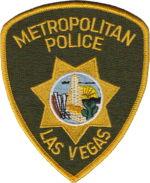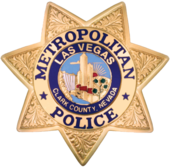|
Las Vegas Metropolitan Police Department
The Las Vegas Metropolitan Police Department (also known as the LVMPD or Metro) is a combined city and county law enforcement agency for the City of Las Vegas and Clark County, Nevada, United States. It is headed by the Sheriff of Clark County, who is publicly elected every four years. The sheriff is the only elected head law enforcement officer within the county, and, as such, the department is not under the direct control of its jurisdictional cities, Clark County, or the State of Nevada. Metro is the largest law enforcement agency in Nevada, and in 2009, was one of the largest police agencies in the United States according to Uniform Crime Reporting by the Federal Bureau of Investigation.[3] The Clark County Detention Center is one of the largest jail systems in the United States, as well. HistoryThe Las Vegas Metropolitan Police Department (LVMPD) was formed on July 1, 1973, by merging the Las Vegas Police Department with the Clark County Sheriff's Department. Metro serves the city limits of Las Vegas and the unincorporated areas and towns of Clark County. In the early 1970s, both the Las Vegas Police Department and the Clark County Sheriff's Department struggled with jurisdictional and budgetary problems. Oftentimes, people living in the metropolitan area would call the wrong agency to report crimes in progress, which would delay police response. Both agencies were also strapped for manpower, yet used a lot of it duplicating record-keeping and administrative functions in both of the agencies. The idea of consolidating the two law enforcement agencies into one metropolitan department began to circulate among the top officials in both agencies, likely due to the close working relationship between the Clark County Sheriff and the Las Vegas Police Chief at that time. It was said that even police officers on the Las Vegas Police Department could see that it would be better if the agency were run by the Sheriff, due to the fact that he was an elected official. Legislation to merge the Las Vegas Police Department with the Clark County Sheriff's Department was passed by the Nevada State Legislature, and the merger became effective in 1973.[4] In 1999, an outside audit conducted by DMG-Maximus, commended the department for having fewer managers and supervisors than are typically found in large police agencies. The audit also said that the managers, both sworn and civilian, were of "excellent quality".[5] On January 5, 2015, the Las Vegas Metropolitan Police Department officially assumed responsibility for the Las Vegas Township Constable's Office.[6] Las Vegas Township Constable's Office continues to be a separate entity but under Metro's Detention Services Division.[7] The Las Vegas Metro Police Department has more than 5,800 members. Of these, over 2,900 are police officers of various ranks and over 750 are corrections officers of various ranks.[citation needed] In November 2024, venture capitalist Ben Horowitz was reported to have funded at least $7.6 million in LVMPD purchases during the previous few years, and to have acted as facilitator between the department and at least six of his a16z portfolio companies. Purchases from Horowitz's donations include Skydio drones,[8] in which he was an early investor.[9] MisconductSince the late 1970s, more than 100 LVMPD officers and civilian employees have been implicated in documented instances of police misconduct and/or actual criminal activity, with numerous incidents resulting in lawsuit settlements in excess of a million dollars apiece. A later excessive force case was tried in Davis v. City of Las Vegas. According to the New Yorker, the LVMPD had "a long-standing reputation as one of the most violent in the country" before it implemented reforms, in conjunction with the U.S. Department of Justice, in the 2010s.[10] Radio systemLVMPD operated on a digital radio system (DesertSky), which was turned on in 2011. As of February 2018, the Las Vegas Metropolitan Police Department encrypted their radio frequencies; blocking the public from using police scanners, with no delayed web feed provided. The Las Vegas Metropolitan Police Department stated that the decision to encrypt their radio channels was made back in 2015 due to officer safety concerns.[11] Vehicle fleet Las Vegas Metro uses many vehicles from brands including Ford, Hyundai, Nissan, Jeep, Buick, and Chevrolet as marked or unmarked vehicles. However, after the retirement of the Ford Crown Victoria in 2011, the Las Vegas Metropolitan Police went through a short session of testing vehicles. As a result, the Ford Explorer took the place of the Crown Victoria, the main patrol vehicle.  HeadquartersConstruction was completed on LVMPD's 370,500-square-foot headquarters, located at 400 S. Martin L. King Boulevard, in mid 2011. The building consolidated 27 bureaus, which were previously located in leased buildings around Las Vegas. It also houses the Southern Nevada Counter Terrorism Center, Police Records, and a Fingerprint Bureau annex. FundingThe police services of the department are funded by both the City of Las Vegas and Clark County. Police services funding is based on a complex formula that includes population, calls for service, and felony crimes in the prior year. Both entities must approve the annual budget, including the percentage of budget they are responsible for. The department itself generates approximately 33% of its funds through property tax, and the charging for certain services, such as special events, work cards, and privileged license investigations. Additional funding is generated from a special sales tax to fund commissioned positions. By state law, the sheriff is charged with running the county jail, known as the Clark County Detention Center or CCDC, which is funded solely by the government and tax base of Clark County. Additionally, the police functions at Harry Reid International Airport are also solely funded by Clark County. OrganizationThere are two commissioned career tracks in the LVMPD. They have identical civil service rank structures and pay, but different day-to-day tasks and responsibilities.
The LVMPD is divided into ten urban area commands:
When Metro was formed in 1973, the Las Vegas Valley was served by only three area commands: North, South and West. Other major coverage details: Traffic Bureau (all sectors), Airport Division (Sector Q), and nine different rural areas outside the Las Vegas Valley. Rank structureThe LVMPD rank structure is as follows: Enforcement areas This department provides law enforcement services for all of Clark County, including the City of Las Vegas, yielding primary jurisdiction to the following agencies:
StructureThe LVMPD is led by the sheriff; second in command is the undersheriff, who is assisted by three assistant sheriffs. The Office of Intergovernmental Services, the Office of General Counsel, the Office of Public Information, the Office of Finance, The Police Employee Assistance Program (PEAP), and the Office of the Sheriff Executive Staff report to the undersheriff. Four of the six elected Clark County sheriffs since the LVMPD was consolidated in 1973 are former members of either the Clark County Sheriff's Office (CCSO) or Las Vegas Police Department (LVPD). Former Sheriffs Young and Gillespie are retired members of the LVMPD (that is they were commissioned solely as members of the LVMPD). Sheriff Gillespie rose to, and retired at, the appointed rank of undersheriff prior to assuming public office as the duly elected Sheriff of Clark County. The department operates the Clark County Detention Center. It is used to house inmates arrested in their patrol area, with the exception of misdemeanors committed in the City of Las Vegas, which maintains its own jail. It also holds persons who are wanted for extradition to another jurisdiction, persons who are awaiting a bail hearing or trial, or those persons serving a sentence of 364 days or fewer. The CCDC has been the subject of controversy surrounding the treatment of inmates by officers. The facility has been criticized for its violations of human rights, with a major focus on verbal and sexual abuse to inmates as well as the use of controversial spit mask restraint for resistive detainees during the booking process. There have been several instances of pre-trial detention lasting for years at a time. EquipmentFirearms policyFirearms training takes place at the LVMPD's John T. Moran Firearms Training Facility, located near Nellis Air Force Base, and named for the department's second sheriff. The facility is used by numerous local, state, and federal law enforcement agencies. At the facility, recruits receive several weeks of firearms training during the academy. Commissioned police and corrections officers must attend firearms re-qualification four times a year. This re-qualification is for all firearms. The qualifications include known-distance targets and tactical courses of fire in both regular and low-light. Officers can choose their sidearm from a list of semi-automatic pistols manufactured by Beretta, Colt, Glock, Heckler & Koch, Kimber, Para-Ordnance/Para USA, Ruger, SIG Sauer, Smith & Wesson, CZ P Series, Springfield Armory, Steyr Mannlicher, Unertl, Walther, Wilson Combat, STI Staccato P. The preferred calibers are 9×19mm Parabellum, .40 S&W, and .45 ACP.[12] As of 2016, new academy recruits must qualify with an approved 9mm pistol. Officers are also allowed to customize their sidearms with such as slide serrations, compensators, flared mag wells, etc. Officers can also install Red Dot Sights/Optics on their service pistols but only after they completed their FTEP Phase and attend the specified training course. Pistols
RiflesNon-lethalCrowd controlVehiclesUAVsIn popular culture
See also
References
External links |
||||||||||||||||||||||||||||||||||||||||||||||||||||||||||||||||||








